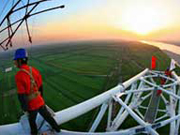China investing in green and nuclear technologies

 0 Comment(s)
0 Comment(s) Print
Print E-mail CNTV, September 24, 2014
E-mail CNTV, September 24, 2014
China's Vice-Premier Zhang Gaoli is attending the UN Climate Change Summit in New York. But at home, efforts are already underway to develop alternative energies and pursue a green economy.
A clear message from the Chinese government.
Last week, ahead of the UN Climate Change Summit, the State Council approved a national plan with specific targets to tackle global warming. Among them, it called for about 15 percent of the country's energy consumption to come from non-fossil fuels by 2020, up from 9.8 percent at the end of 2013.
Clean energy is expected to account for over half of China's energy consumption by 2050. Which explains why investors have been increasingly keen to bet their money on alternative energy.
"In China, investment in this sector has reached 6 billion US dollars last year, which is very high globally. And our new energy installation reached two-hundred gigawatt, which is a big achievement in China," Wang Huidong, director of strategy mgmt. center, hanergy holding group, said.
Chinese authorities have set alternative energy as a strategic priority. Subsidies have been created to encourage companies to invest more in wind, solar, and hydro technologies.
China currently has the world's largest installed capacity for wind power. And it intends to further double its number of wind turbines over the next six years.
The country's solar power capacity is also expected to surge to 10 million kilowatts by 2020.
On top of that, nuclear technology has emerged as an appealing alternative.
Compared with developed countries, China is a late-comer to nuclear power. It has relied on more traditional energy sources, like fossil fuels, to power the country's continuing economic growth, and its construction of nuclear reactors has been slow. But the government is now taking steps to change that.
Sitting on China's southern coast, the Daya Bay Nuclear Power Plant was the country's first commercial nuclear power plant.
70 percent of the plant's output is piped to Hong Kong, and the rest goes to China Southern Power Grid.
It is described as a cleaner energy alternative to the more widely used method — coal.
"Our base produced 44.16 billion kilowatts of electricity last year. Over 14.4 million tons of standard coal are needed to produce the same quantity of electricity. That means we avoided emitting 35 million tons of carbon dioxide and 340 thousand tons of sulfur dioxide," Zhao Fuming, deputy chief engineer of Daya Bay Nuclear Power Operation & Mgmt. Co., said.
China currently has 20 nuclear power plants. 28 more reactors are already under construction. By 2020, the country expects that six percent of its electricity will be produced by nuclear power. It's just one of the many goals toward creating a greener future.






Go to Forum >>0 Comment(s)